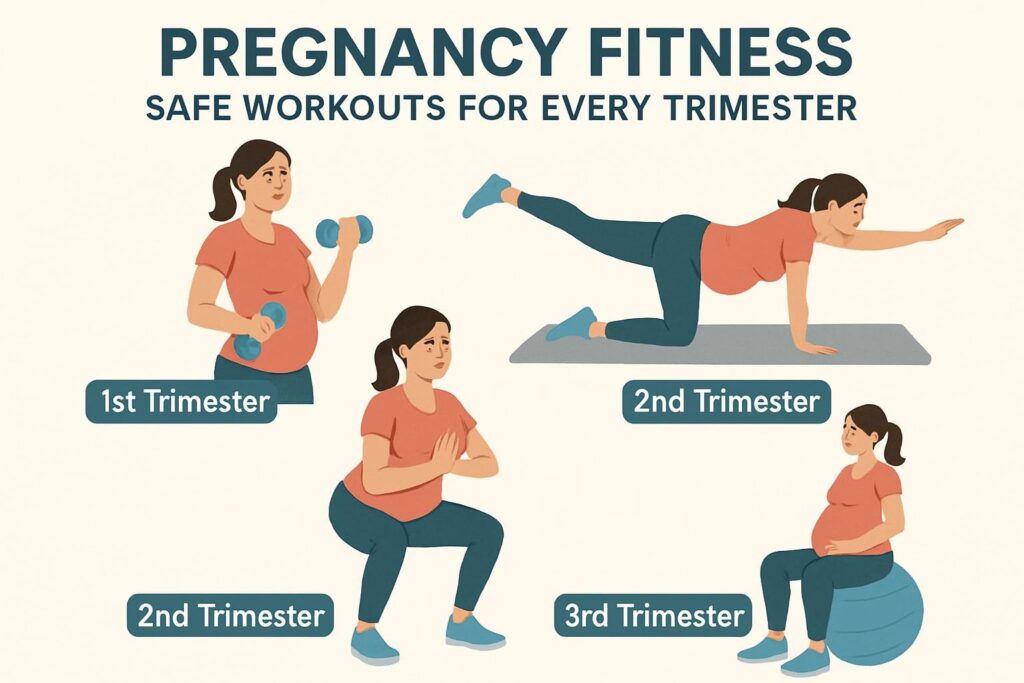
Pregnancy is a beautiful journey that brings many changes to a woman’s body. Staying active during pregnancy is beneficial for both the mother and the baby. However, it’s essential to choose safe workouts tailored to each trimester to ensure the health and safety of both. In this article, we will explore the best pregnancy fitness routines for every trimester, tips for exercising safely, and the benefits of staying active during pregnancy.
Benefits of Exercising During Pregnancy
- Improves Mood and Energy Levels: Exercise releases endorphins that help reduce stress, anxiety, and depression.
- Enhances Sleep Quality: Regular physical activity can help you fall asleep faster and enjoy deeper sleep.
- Boosts Circulation: Helps reduce swelling and leg cramps.
- Strengthens Muscles and Joints: Prepares your body for labor and delivery.
- Promotes Healthy Weight Gain: Helps manage weight gain within recommended limits.
- Reduces Pregnancy Discomforts: Alleviates back pain, constipation, and bloating.
- Speeds Postpartum Recovery: Improves muscle tone and overall fitness for after birth.
General Safety Tips for Pregnancy Workouts
- Consult your healthcare provider before starting any exercise routine.
- Stay hydrated and avoid overheating.
- Wear comfortable, supportive clothing and footwear.
- Avoid lying flat on your back after the first trimester.
- Listen to your body and avoid overexertion.
- Avoid high-impact and contact sports.
- Stop exercising immediately if you experience dizziness, bleeding, contractions, or chest pain.
First Trimester (Weeks 1-12)
During the first trimester, your body undergoes hormonal changes and early pregnancy symptoms like fatigue and nausea. Exercise can help combat these symptoms.
Recommended Workouts:
- Walking: A gentle, low-impact way to stay active.
- Prenatal Yoga: Promotes flexibility, relaxation, and stress relief.
- Swimming: Supports your body weight and reduces joint strain.
- Light Strength Training: Using light weights or resistance bands to maintain muscle tone.
Tips:
- Keep workouts moderate; avoid high-intensity routines.
- Focus on proper breathing and posture.
- Avoid exercises that require balance on one leg to prevent falls.
Second Trimester (Weeks 13-26)
The second trimester is often called the “honeymoon phase” because many women feel more energetic and experience less nausea.
Recommended Workouts:
- Prenatal Pilates: Improves core strength and posture.
- Stationary Cycling: Low-impact cardiovascular exercise.
- Water Aerobics: Provides resistance and buoyancy for a full-body workout.
- Modified Strength Training: Continue with safe resistance exercises.
Tips:
- Avoid exercises that involve lying flat on your back.
- Use props like chairs or walls for support.
- Monitor intensity and avoid overheating.
Third Trimester (Weeks 27-40)
As your belly grows, balance and mobility become more challenging. Focus on gentle movements and preparing your body for labor.
Recommended Workouts:
- Gentle Walking: Keeps you active without strain.
- Prenatal Yoga and Stretching: Enhances flexibility and reduces tension.
- Pelvic Floor Exercises (Kegels): Strengthen muscles to support labor and recovery.
- Swimming or Water Walking: Relieves pressure on joints and back.
Tips:
- Avoid high-impact or strenuous activities.
- Take frequent breaks and stay hydrated.
- Focus on breathing techniques and relaxation.
Sample Pregnancy Workout Routine
Warm-up (5-10 minutes): Gentle walking or marching in place.
Main Workout (20-30 minutes):
- 10 minutes of prenatal yoga or stretching.
- 10 minutes of light strength training (e.g., squats, wall push-ups).
- 5-10 minutes of low-impact cardio such as stationary cycling or swimming.
Cool-down (5-10 minutes): Slow walking and deep breathing exercises.
Important Exercises to Avoid
- High-impact aerobics or jumping.
- Contact sports like basketball or soccer.
- Exercises involving lying flat on your back after the first trimester.
- Heavy weight lifting or intense resistance training.
- Activities with a high risk of falling (skiing, horseback riding).
- Hot yoga or exercises in high heat/humidity environments.
Nutrition and Hydration Tips for Active Pregnant Women
- Drink plenty of water before, during, and after exercise.
- Eat balanced meals with sufficient protein, healthy fats, and complex carbohydrates.
- Include foods rich in iron, calcium, and folic acid.
- Avoid exercising on an empty stomach; have a small snack if needed.
When to Stop Exercising and Seek Medical Advice
Stop exercising and consult your healthcare provider if you expStaying active during pregnancy is highly beneficial when done safely. Tailoring your workouts to each trimester helps you maintain fitness, manage discomfort, and prepare your body for childbirth. Always listen to your body and consult your healthcare provider before beginning or modifying your exercise routine. With the right approach, pregnancy fitness can be an empowering and enjoyable part of your prenatal journey.
Note: Always consult with your healthcare provider before starting any new exercise program during pregnancy.